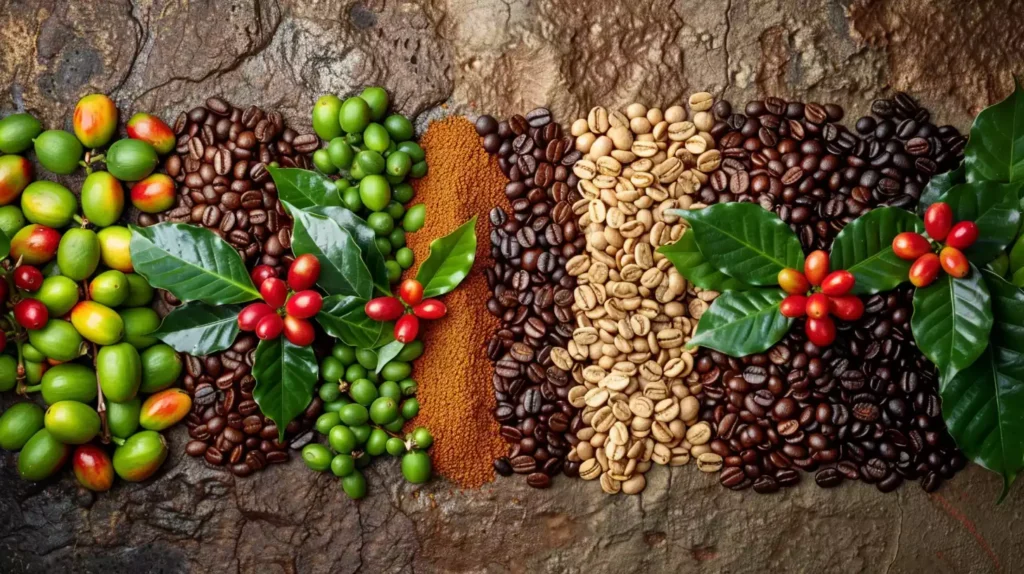If you know your coffee, you will know that Hawaii is the only place in the US that produces coffee. You do not walk into a cafe and ask for a cup of ‘Texas light roast’ but a beautiful ‘Hawaiian Kona’ instead.
Hawaiian coffee is known for its great quality, and some varieties are so good it is one of the priciest in the world. What is so special about Hawaiian coffee? What makes it so good? We will try to answer these in this ultimate guide to Hawaiian coffee.
Hawaiian coffee is usually grown on the Big Island of Hawaii, although some, such as Maui, are not. Hawaiian coffee is known for its medium body with subtle syrupy sweetness. Tasting notes include hints of fruit, chocolate, and nuts. A pound (0.45 kg) of some Hawaiian coffee can cost up to $60.

What Is Hawaiian Coffee?
Hawaiian coffee refers to coffee beans grown in Hawaii, mainly the Big and neighboring islands. Known for its smooth, well-balanced flavor, Hawaiian coffee is also one of the world’s priciest, reaching over $60 a pound. Varieties of Hawaiian coffee include Kona, Ka’u, Puna, or Maui.
Hawaiian coffee largely refers to the coffee beans grown in Hawaii (also known as the “Big Island”) and the islands on the Hawaii Island Chains.
Hawaii’s coffee is known for its unique flavor, from the volcanic soil, tropical climate, and perfect altitude for growing coffee. Hawaiian coffee is now thought to be some of the best tasting in the world and has a smooth, well-balanced flavor.
European settlers planted the first coffee trees in Hawaii in the early 1800s. This was the start of coffee farming in Hawaii. But coffee production in Hawaii did not grow until the late 1800s when large-scale coffee plantations were set up on the islands.
Hawaiian coffee is also well-known for the way it is grown. Many farmers in Hawaii grow their coffee using organic and shade-grown methods, which helps protect the environment and keep the islands’ unique biodiversity.
Kona coffee is one of the most well-known types of Hawaiian coffee. Kona coffee is known for its unique flavor profile, including notes of chocolate, nuts, and spice.
Aside from Kona, other varieties are also growing in popularity and are set to complement Hawaiian coffee’s range. These include Ka’u and Puna coffee from the Big Island and Maui coffee from Maui.
What Makes Hawaiian Coffee Special?
Hawaiian coffee is special for many reasons, such as being small in amount and being grown in unique conditions. Hawaiian coffee is also mostly grown organic and hand-picked. This results in great-tasting coffee with a proud American heritage.
Hawaiian coffee is seen as special and different in the eyes of many drinkers in many ways.
These differences may not be significant on their own. Still, when added up, they resulted in a unique characteristic for Hawaiian coffee, becoming one of the world’s most pricey coffee.
Rarity
Hawaiian coffee is special because it is rare. Hawaii commonly produces around 7 million pounds of coffee annually (about 3.17 million kgs).
When you compare that number to worldwide coffee production of about 23 billion pounds (about 10 billion kgs), that is a minuscule figure. Hawaiian coffee is less than 1% of worldwide coffee production.
This means Hawaiian coffee is a rare commodity, and people in the coffee industry hunt for it, from roasters to drinkers who fall in love with it. As a result, Hawaiian coffee is seen as something special, and people will happily pay top dollar to get them.
Growing Conditions
Hawaiian coffee is grown in volcanic soil, tropical environment, and optimal elevations for coffee growing. This makes it different from many other coffee regions.
Wide varieties of Hawaiian coffee, such as the Kona, Puna, or Ka’u, are grown on the slopes of Mauna Loa, Hualalai, and several other volcanoes. The volcanic soil on these mountains is rich in minerals and offers the coffee plants the best growing conditions.
The long maturity period for the coffee cherries caused by the tropical temperature and high elevations also contributes to developing a more rich and more subtle flavor. As a result, Hawaiian coffee produces tastes and flavors that are unique and loved by many.
Growing Method
Coffee planters in Hawaii are known to grow their coffee naturally, with little use of chemicals. They apply sustainable farming techniques, such as organic and shade-grown techniques. This not only contributes to environmental protection but also produces great-tasting coffee. In fact, many coffee lovers seek out Hawaiian-grown coffee for its quality and sustainable practices. The result is some of the best organic coffee in the world, with unique flavors and a smooth finish. By supporting these coffee planters, consumers can enjoy their favorite brew while also helping to preserve the environment.
Many farmers in Hawaii also engage in diversified agriculture, which entails growing a range of crops on their farms. This helps to replenish the nutrients in the soil and prevent crop failure.
Unique Flavor
The unique growing conditions and farming practices eventually produced high-quality coffee that many drinkers love. Hawaiian coffee also offers a variety of tastes, depending on growing regions.
For example, Kona coffee is known for its smooth, mild flavor with hints of chocolate, nuts, and spice. Ka’u coffee is known for its rich, full-bodied flavor with hints of caramel and dark chocolate.
Many people describe exploring coffee in Hawaii as akin to exploring wine regions in France. This may explain the variety of tastes and enjoyment you can derive from trying Hawaiian coffee.
Proudly American
Hawaii is the only place where coffee is grown in the United States. This makes Hawaiian coffee special in the eyes of many, and they are keen to ensure their money goes back to supporting local farmers.
This makes Hawaiian coffee special in the eyes of many people as well.
What Are The Main Types Of Hawaiian Coffee?
There are many variants of Hawaiian coffee. However, the most well-known are Kona, Maui, Kauai, Ka’u, and Puna. There are also variants such as Hamakua and Molokai. These coffee variants are grown in different regions in Hawaii and may carry different tasting notes.
| Coffee Variety | Growing Region | Production (coffee cherries) | Tasting Notes |
| Kona | Kona region of the Big Island, on the eastern slopes of Mauna Loa and Hualalai volcano | 20 million pounds (about 9 million kgs) | Chocolate, nuts, and spice. |
| Maui | Island of Maui, northeast of the Big Island | 2 million pounds (about 0.9 million kgs) | Brown sugar, milk chocolate, citrus, and berries. |
| Ka’u | Ka’u region of the Big Island, on the southern slopes of Mauna Loa volcano | 4.8 million pounds (about 2.2 million kgs) | Caramel and dark chocolate. |
| Puna | Puna region of the Big Island, on the slopes of Mauna Loa and Kilauea volcano | 245,000 pounds (about 111,000 kgs) | Herbs, nougat, and citrus. |
| Kauai | Island of Kauai | 10 million pounds (about 4.5 million kgs) | Malt, fruits, and berries. |
| Hamakua | Hamakua region of the Big Island, on the slopes of Mauna Kea volcano. | – | Chocolate, nuts, and fruit. |
| Molokai | Island of Molokai, on the slopes of Kamakou volcano | 285,000 pounds (about 130,000 kgs) | Chocolate, nuts, and spice. |
Hawaii is a large region with many islands, providing different soil conditions to grow coffee. This resulted in various coffee variants with different tastes and flavors.
There are many major Hawaiian coffee variants, with several that are more well-known and popular.
Kona
This is the most famous and popular type of Hawaiian coffee. With over 20 million pounds produced yearly, it is also the most common Hawaiian coffee you may find.
Kona coffee is grown on the Kona and South Kona districts of the Big Island (Hawaii), on the high slopes of Mauna Loa and Hualalai volcano. Over 900 coffee farms operate in this region.
The rich volcanic soil, constant sunshine, and cool sea breezes in the Kona region help to produce coffee with a mild flavor with hints of chocolate, nuts, and spice.
Maui
Maui coffee is an upcoming variant of Hawaiian coffee, with styles such as Maui Mokka in the rage right now. Over 315 coffee farms operate here, producing over 2 million pounds annually for global consumption.
Maui coffee is grown in the upcountry area of the island of Maui, northeast of the Big Island. Maui coffee has a smooth and well-balanced flavor with hints of chocolate, nuts, and fruit.
Ka’u
Ka’u coffee is also grown on the Big Island, in the Ka’u district. The district lies in the south of the island. Over 500 coffee farms operate in this region, producing over 4.8 million pounds of coffee annually.
Ka’u coffee is appreciated for its rich, full-bodied flavor with hints of caramel and dark chocolate. It is also grown at a higher altitude than Kona coffee, which makes it taste different, and hence has its own fans.
Puna
Puna coffee is also a variety of Hawaiian coffee grown on the Big Island. Puna coffee covers the Puna district, stretching around the slopes of Mauna Loa and Kilauea volcanoes. It is a small region with about 20 farms operating.
Puna coffee has a smooth taste with hints of chocolate, nuts, and fruit. It is also one of the rare Hawaiian coffees you can find, with an annual production of only 245,000 pounds.
Hamakua
Hamakua is also a small and upcoming coffee region in Hawaii with a lot of potential. It is also on the Big Island but on the north and northeast sides. Hamakua coffee is commonly planted on the slopes of Mauna Kea volcano, with only 15 farms operating.
Hamakua coffee has an easy-to-sip characteristic. It is a smooth, well-balanced flavor with notes of chocolate, nuts, and a hint of fruit.
Molokai
Molokai coffee is grown on Molokai island between Maui and Oahu. Molokai is a growing coffee region, with over 150 acres of land planted with coffee trees. Over 285,000 pounds of coffee were produced here, making it one of the rarest Hawaii coffees you can get.
Molokai coffee has a richer, full-bodied flavor with chocolate, nuts, and spice notes. This makes it different from many other variants of Hawaiian coffee. It is grown on the slopes of the Kamakou volcano.
Tips When Buying Hawaiian Coffee
When buying Hawaiian coffee, ensure the coffee beans are 100% Hawaiian. Check the bean quality gradings, and always buy unflavored, whole coffee beans for the best freshness and flavor.
You can purchase Hawaiian coffee from many places, such as your local cafe, or from online roasters, such as Volcanica or Koa Coffee.
However, when buying Hawaiian coffee, ensure you follow these tips to ensure you purchase the best coffee for your money:
Ensure It’s 100% Hawaiian
Hawaiian coffee is expensive, which makes it a prime name to be used by many unscrupulous coffee merchants to try to make a quick buck. Their strategy? Mix a small amount of Hawaiian coffee with other cheaper beans, then sell it to you as ‘Hawaiian Blends’ at a high price.
It would help if you avoid these and always go for 100% Hawaiian coffee. If possible, look for single-origin Hawaiian beans, such as 100% Kona, 100% Maui or 100% Molokai. This ensures you get the taste of the local farms.
Check Bean Gradings
Hawaiian coffee beans are graded into several levels, such as Peaberry, Extra Fancy, Fancy, Number 1, Prime, or Select. These gradings refer to things such as the bean size, the presence of holes, and coloration.
When buying Hawaiian coffee, check with the seller on the grading of the beans, and ensure you get the best grading possible for your money.
Buy Unflavored, Whole Coffee Beans
Sometimes some coffee makers try to sell low-grade Hawaiian coffee by applying additional treatments. Common methods include flavoring the coffee by coating it with chocolate or syrup or grinding the beans down into grounds.
When shopping for Hawaiian coffees, ensure you buy unflavored, whole coffee beans. This ensures you are getting the best quality beans. Plus, beans stay fresh longer, which means you will get the best taste for your coffee when you drink it.

